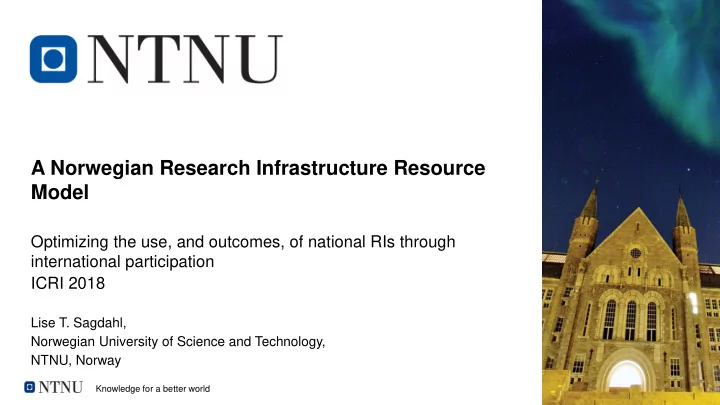

A Norwegian Research Infrastructure Resource Model Optimizing the use, and outcomes, of national RIs through international participation ICRI 2018 Lise T. Sagdahl, Norwegian University of Science and Technology, NTNU, Norway Knowledge for a better world
Knowledge for a better world
Who will cover operational costs and upgrades? • Governments • RI host institutions • Funding agencies • Donors • Users • All of the above? If the users are going to pay, we have to enable them to do so! Knowledge for a better world
New York Times: The Elephant in the Room, Banksy exhibition, 2006 Knowledge for a better world
Project funding in Norway General approach (small and medium sized RI): • Operational costs and depreciation costs should be covered by the projects that use the RI. • These costs are eligible costs in all the Research Council of Norway’s financing schemes. Exceptions: • The RCN may in some cases allocate basic funding of operational costs of large-scale RI. Knowledge for a better world
How do we determine the cost of use of an RI? The Research Infrastructure Resource Model (RIR-model) • Developed in 2013 • Implemented in 2015 for RIs hosted by Norwegian universities, including all roadmap infrastructures. Based on ideas in “Non -paper on direct costing of large research infrastructures” from the European Commission, 2013. Knowledge for a better world
Developing a costing methodology for RI • Full cost approach • Collaborate Funding agencies Ministry of research Host institutions Researchers Administrators • Minimize bureaucracy • Keep it as simple as possible , within laws and regulations • Careful implementation to avoid barriers for unfunded projects Knowledge for a better world
Types of costs in the RIR-model 1. Space – rental and building related costs for research space such as laboratories and workshops 2. Scientific equipment – depreciation costs 3. Common operating consumables and service- / maintenance contracts, i.e. shared costs for all users 4. Technical support – personnel costs for the technical support staff needed to keep the research infrastructure operational Knowledge for a better world
Rate for access Included (blue) The capacity equals the total number of user hours a RIR is designated for in a normal operating Additional rates (red ) phase. Additional rate – technical staff Flat rates per year based on on project average use. Knowledge for a better world
Benefits of RIR model • Project financing from major funders now includes RI costs - enables users to pay, stable funding if the RI is used • Common methodology for calculating prices – can be used for all RIs - transparency and simplification, but trust is key • Better data for strategic management information - more realistic planning of new RIs • Awareness of costs - sustainability - regulates the “cry for more, bigger and better” • Clarity on state aid issues (Europe) - Maximum 20 % economic activity Knowledge for a better world
Challenges • Change the culture from "low- cost" to “full cost» - activities are seemingly more expensive • Defining capacity of RI - who pays for idle/unused time? • Time recording/booking systems • Keeping the transaction costs low, avoiding unnecessary administration • National model - not all foreign users/projects have funding - host institutions will often provide funding based on excellence Knowledge for a better world
Summary • “The Norwegian RIR model” provides a simple methodology to calculate RI costs for most RIs. • If RI costs would be considered eligible costs in all financing schemes , we can focus on the science and maximize the use and value of RIs through international participation. Knowledge for a better world
Thank you! More on the model: https://www.uhr.no/_f/p1/i7917a849-7f91-49c4-9e66- 55d715c525ba/a_norwegian_research_infrastructure_resource_model_270214.pdf Contact: Lise T. Sagdahl, NTNU, lise.sagdahl@ntnu.no Knowledge for a better world
Recommend
More recommend